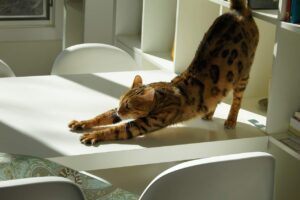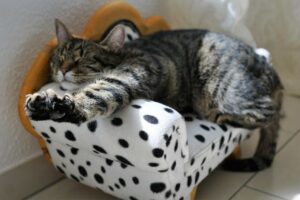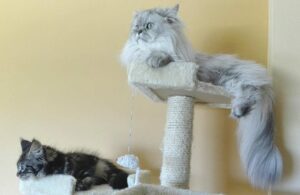Do you have a cat that keeps scratching on your favourite furniture? Scratching is a natural feline behaviour and cats do it due to various reasons. If you understand why they scratch then you can also learn how to Stop Your Cat from Scratching on Furnitures. Let’s look into the reasons for scratching, what it signifies and how we can prevent damage to our belongings without causing any harm to our cats or without affecting their scratching requirements.
Why Do Cats Scratch?
Scratching is not really a sign of destructive behaviour or a behavioural issue in cats. It comes to them naturally. Scratching releases “feel-good” hormones and keeps your cat healthy. Though excessive scratching may indicate an underlying stress or behavioural issue, in general both domestic cats and wild cats scratch on different surfaces due to various reasons. Let’s have a look at it one by one.

1) To Mark Territory- Cats are territorial animals. It is their natural instinct to mark their territory. A unique smell is released from cats’ paw glands when they scratch. That smell assures their possession in your house. They feel secure in their house whenever they sniff that smell. So it is a way for cats to claim their right on your belongings. They are after all the most loved member of your family!
2) To Keep their Claws Healthy- Young kittens scratch to remove the outer shell of their nails. This habit continues even when they grow up. It helps them to keep their claws healthy and sharp.
3) Stretching- Cats may simply scratch as a part of their stretching exercise. As they stretch their muscles and extrude their claws, they can leave scratch marks on your furniture.

4) To Relieve Stress- If you notice a sudden increase in the frequency of scratching it may be due to their increased stress level. If there is any sudden change in your house or any outside noise bothers your cat then they may feel anxiety and stress. Be very patient in that case. Shower all your love and attention on your cat to assure them that everything is fine.
5) Out of Boredom- Apart from the instinct driven , emotional & biological needs cats may also scratch the furniture out of boredom. Cats are very curious by nature. They like to explore everything within their reach. If they do not get that exposure or enough playtime then that may lead to more frequent scratching.

How to Stop Your Cat from Scratching Furniture?
1) Place Adequate Scratching Pads- It is not possible to stop your cat from scratching as it is their natural instinct. However, it is very much possible to redirect them to dedicated scratching pads. Place scratching pads near the furniture that your cat likes to scratch more often.
Apart from this, place adequate scratching pads in your house. Make sure they are well accessible to your cat. Gradually you will notice that they will start scratching those pads instead of your furniture. It may not happen overnight but gradually you will notice a change in their scratching behaviour.
2) Install Scratching Posts- Another effective way to Stop Your Cat from Scratching Furniture is to install Scratching posts in your house. It will act as their very own private space to chill. Cultivate your cat’s curiosity by hanging toys from their posts, scenting the post with catnips etc.

3) Keep them Engaged in Other Activities- As mentioned earlier, excessive scratching by cats may be due to simple boredom. Make sure that your cat gets adequate playtime and engagement. Activities like a walk in the park, interaction with you and your family members, socialization activities etc help to engage your cat so that they do not feel bored. There are plenty of cat toys available in market that can keep your cat engaged. Get some toys for your cat and spend time with them while they learn to play with those toys.

4) Use Sticky Paws- Sticky paws are another effective solution to stop your cat from scratching furniture. It is a double sided tape that works as a cat scratching deterrent. Sticky paws are made of non-toxic, medical grade adhesive and are easy to apply or remove. It helps to deter your cat from scratching on furniture and also prevents them from stepping into all those corners of your house where you do not want them to go.
5) Discourage Undesired Behaviour- You can stop your cat from scratching furniture as a part of their behavioural training as well. If you catch them scratching on furniture, discourage them by gently removing them from that place. Praise them and offer their favourite treats if they do not repeat it or move to dedicated scratching pads. Your cat will gradually learn what you expect from them and how they can get rewards (treats).
Remember: Do not use physical force while redirecting them to scratching pads. It may confuse them. Physical punishments are not only cruel but also not effective on pets. In fact it may invite adverse behavioural pattern in your cat and may negatively impact your bond with them. Positive reinforcement is the only proven method to correct behavioural issues in pets.
6) Use Furniture Guards- Furniture guards are an excellent remedy to protect the furniture in your house from cat scratches. This do not affect your cat’s scratching habits but only protects your belongings from damage. There are plenty of sturdy furniture guards available in the market.

Please Note:
- Many Cat Parents declaw their cats to prevent them from scratching. Please do not consider anything like that. It is a painful surgery. It is not only cruel but also not good for your cat’s health. It can cause pain, infection, trauma, tissue necrosis and other issues. Scratching is a natural feline behaviour and declawing them may cause other health risks or behavioral issues if their natural behaviour is restricted.
- If you notice any destructive behaviour in your cat that is beyond control and needs an expert’s intervention then please do consult with an animal behaviourist. They can help you understand the exact issue and guide you with an effective solution.

